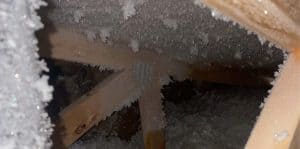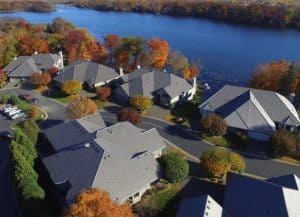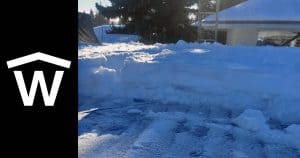For asphalt shingle roofs, having a missing shingle is one of the most common roof repairs that lead to water leaks. Just as hair serves as a protective layer for our heads, roof shingles shield our homes from the elements. Unfortunately, when shingles start disappearing, it’s not just an aesthetic concern – it’s a significant problem for residential roofs. The good thing to know is that, unlike the shingles you get with old age, a missing roof shingle is an easier experience.

Whether you’re a homeowner of an asphalt shingle roof who has noticed that your roof is missing shingles after a storm, or someone keen on understanding roofing maintenance, this guide is tailored for you.
Our goal is to provide information on the potential damage caused by missing shingles, including issues like roof leaks, and the necessary steps to address this issue. Even if you’re new to roofing and found us through a simple search term like ‘’shingles missing on roof’’, rest assured, we’re here to guide you through the process.
Keep in mind, while a missing shingle might give your roof a “bald spot”, resolving this roofing issue requires more than a quick comb-over and should be addressed before you have a roof leak. Although this applies to missing shingles, most of what is being talked about can be applied to broken or damaged shingles.
What Causes Missing Shingles
Firstly, missing shingles on your roof can be a result of various factors. Understanding these causes is the first step towards effective roof maintenance and can help you prevent future shingle loss. Let’s delve into some of the most common causes.
Environmental Factors Leading to Missing Shingles
While roofs are designed to withstand the elements, Mother Nature can sometimes be exceptionally tough. Over time or under extreme conditions, environmental factors can lead to missing shingles. Here are some of the key environmental culprits.
- High Winds: While roofs are built to withstand typical windstorms, severe windstorms or unusually high winds can lift shingles, causing wind damage to your shingled roof. In extreme cases, these winds can rip shingles off their nails, you can read more from: Roof Damage From Wind.
- Heavy Rain, Hail, or Snow: While occasional rain, hail, or snow won’t typically damage your shingles, unusually heavy or prolonged weather conditions can. These extreme conditions can weaken your shingles, making them more susceptible to being blown off, as well as be the main cause of damage via a roof leak once a shingle is missing.
- Sun Exposure: Roofs are designed to endure regular sun exposure. However, over many years, this constant exposure can cause your shingles to become brittle and more likely to break or fall off. This is particularly true in regions with high UV index or intense sun exposure.
Remember, these factors don’t necessarily mean your shingles will go missing. However, they can contribute to the aging and weakening of shingles, making them more susceptible to damage over time. Regular roof maintenance and inspections can help identify potential issues with and old shingle early and prolong the lifespan of your roof.
The Role of Improper Installation in Missing Shingles
Unfortunately, the problem can start at the very beginning of a roofing project, with an improper installation. If you have a new roof but have experienced missing shingles, it’s often due to incorrect installation or inactive seal strips. Here are some installation issues that can lead to missing shingles, even on new asphalt shingles.
Misplaced Nails
Inexperienced roofers might misplace the nails when securing the shingles. If the nails are not installed across the nail strip, the hold will likely fail, causing the shingle to blow up and off. Misplaced nails are a concerning problem because if one shingle was installed that way during the roofing project, chances are high that other shingles have the same problem.
Inactive Seal Strips.
Seal strips won’t activate if the temperatures are too low and there is little to no sun exposure. In these conditions, it could take weeks before the adhesive strip is fully activated and sealed. Wind gusts could cause shingle misplacement during this period for the asphalt shingles.

Indicators of Potential Shingle Problems
While the causes we’ve discussed directly relate to missing shingles, it’s important to note that other roofing issues can serve as indicators of potential shingle concerns. If corners were cut in one area of your roof, it’s possible that the same lack of care was applied to the shingle installation. Here are some other factors to consider. You can read further on What Does A Bad Roof Installation Look Like?
Flashing and Gutters
For instance, if the flashing around your chimney or vents was not installed correctly, it might suggest that the same carelessness was applied to the shingle installation. Similarly, if your gutters are not properly attached, these issues could contribute to shingle loss.
Roof Deck Preparation
If your roof deck was not adequately prepared before the shingles were installed, this could also be a sign of potential shingle problems. Proper roof deck preparation is a crucial step in ensuring the longevity of your shingles.
In essence, a concern in one area of your roof can often signal potential issues in other areas, including your shingles. By being aware of these indicators, you can take proactive steps to prevent shingle loss and avoid the need for a full roof replacement.
The Damage Caused by Missing Shingles
When a few shingles go missing, it’s not just the aesthetic appeal of your home that’s at stake. Missing shingles can lead to a host of roof damage issues that can compromise the structural integrity of your home. Here’s a look at some potential damage caused by missing roof shingles:
Water Damage and Leaks
One of the primary functions of roof shingles is to direct water away from your home. When shingles are missing, water can seep into the underlayment, the decking, or even inside your home. This can lead to water stains, mould growth, and structural damage.
Structural Damage
Over time, the damage caused by missing roof shingles can lead to significant structural issues, including damage to the roof deck, interior walls, and ceilings. In severe cases, it can even lead to a roof collapse.
Given these potential issues, it’s clear why addressing missing roof shingles promptly is so important. In the next section, we’ll discuss how to handle missing shingles and the role of a professional roofer in this process.

Addressing the Issue of Missing Shingles
When it comes to handling missing shingles, prompt action is key. The longer you wait, the more potential there is for further damage to your roof and home. Here’s a general factor to consider for your roofs shingle repair.
Assess the Missing Shingles
The first step is to assess the situation. How many shingles are missing? Is it just a shingle or two, or is there a larger section of your roof exposed? If it’s a small area, you might be able to handle the repair yourself if you have a spare matching set of replacement shingles on hand. However, if it’s a larger area, it’s best to call in a professional. If it is a new shingle missing, then call the roofers in the did the work.
Consider the Age and Condition of Your Roof
If your roof is older or has been showing signs of wear and tear, missing shingles could be a sign that it’s time for a new roof. In this case, patching the missing old shingles might not be enough to prevent future problems.
Missing shingles repair cost
The cost for replacing a missing roof shingles can vary based on several factors. These factors include such things as the slope of the roof, the location of the missing shingle, the type of shingle, and the extent of the damage if it went untreated. If the missing shingle is the only issue, then you’re typically looking at a cost between $100 to ~$400. Keep in mind, we won’t be buying one single shingle or rarely have a suitable one on hand. They come in bundles and that would need to be included into the cost.

DIY or Hire a Professional Roofer?
If your roof is relatively new with new shingles and hasn’t been subjected to an extreme weather event (like a windstorm from a tornado), it’s advisable to contact the roofing company that carried out the original work. However, now, it could be beneficial to seek a second opinion through an independent roofing inspection. This step ensures that the initial installation was done correctly and that your roof is in its optimal condition.
If you’re comfortable doing home repairs, and it’s a small area, you might choose to replace the whole shingle yourself. Your roofer may often leave left over shingles for you to keep in your garage. However, keep in mind that working on a roof can be dangerous, and it’s essential to take safety precautions and is to be avoided, as an incorrectly done job can just cause you more of a headache down the road. Also keep in mind the age of the roof and the age of your replacement shingle.
Before we talk about doing the DIY process, we recommend getting professional roofers involved, especially for larger areas.
We understand that you may prefer a hands-on approach and might be considering a DIY repair. We suggest searching for relevant YouTube videos that provide step-by-step instructions on how to replace missing shingles. Please note that every situation is unique, and that’s why we don’t link to a specific source. As a skilled DIY enthusiast, you should be able to find the most suitable video guide for how to replace missing shingles.
It’s best to hire a professional roofer. A professional can assess the damage, determine the best course of action, and ensure that the repair is done correctly, or roof shingle repair is needed. They can also check for other issues, like leaks, damaged shingles or structural damage, that might not be visible from the outside.
Remember, while it might be tempting to ignore a few missing shingles, doing so can lead to more significant issues down the line. Whether you choose to DIY or hire a professional for missing shingles repair, addressing this issue promptly, can save you time and money eventually. Contact us for your roof shingles repair.


